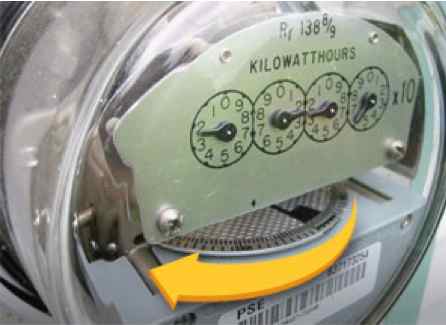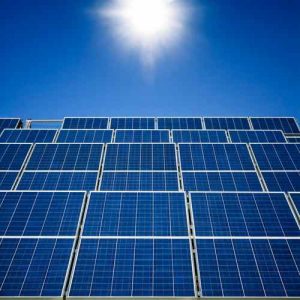Net Metering policy for roof top PVs in various states in India
Solar powered systems can be categorized in two:
- Grid connected solar power system.
- Stand alone Offgrid system.
A grid connected system as the name suggests is the one in which your solar power system is connected to the local main grid. In this case, your loads can run on solar power as long as there is sufficient energy available from the sun during the day. Any deficit is taken care by the main utility supply. However, if the solar energy production is in excess as compared to the load requirement at that moment, the excess energy can be either stored in the batteries (if available) or can be sold back to the utility grid. This difference of energy can be tracked using a meter connected to your solar pv system.
Types of Metering
In a solar powered system, usually following two types metering systems are involved:
- Gross metering
- Net Metering
In gross metering, entire energy generated by the solar PV system is fed back directly into the utility grid. In this case, the owner gets incentives based on feed-in tariffs proportional to the energy fed back to the grid.
However, net metering takes into account the difference of excess energy fed back to the grid and total energy consumed from the grid by the system owner. A detailed explanation about net metering is given below:
What is net metering?
Net metering is an agreement that allows the solar PV system owner to sell excess solar energy to the utility company or buy deficit energy from the utility company using a meter to track this energy exchange.
Following 2 cases take place in this scenario:
Case 1: If at any moment of time, if solar energy generation (kWh) is less than the load requirement at that time, the difference of energy is taken from the main grid and the meter runs forward, as usual. In this case, the system owner is charged for the units (kWh) consumed from the main grid. Eg. During early morning or during late evening/night.
Case 2: If at any moment of time, if solar energy generation (kWh) is more than the load requirement at that time, the excess solar energy is fed back to the main grid and the meter now runs backward. In this case, the system owner gets credit for the units (kWh) fed back to the main grid. Eg. During peak sunshine hours (afternoon)

When you generate extra electricity (more than what you can use) the meter literally moves backwards.
Thus, at the end of the billing period:
If case 1 > case 2, then the owner is charged for the difference of units as per usual retail tariff
If case1 < case 2, then the difference of units is either carried forward to the next billing period or the owner is paid for the difference of units as per the tariff decided by the concerned utility.
(kindly refer your state policy/utility company policy for more information about tariff)
In short, the owner pays/gains for the ‘net’ energy used over the designated period of time.
Meters used in Net metering:
The use of meters in this case differs from State to State. Some states may require only one meter that reads the ‘net’ energy consumed by the system owner. However, few other states may require two meters – one to measure solar energy generation and the second to measure the units consumed from the utility grid.
(Kindly refer your state policy for more information about tariff)
Advantages of Net Metering:
The 3 most important advantages of net metering are:
1. Financial benefit for the system owner
Since the system owner is charged for the net energy consumed from the utility grid, the owner gets financial benefits. Eg. If energy generation < energy consumed: owner pays just for the net amount. If energy generation > energy consumed: the owner gets credit for excess generation.
2. Avoid the use of batteries
In a grid connected solar pv system, any excess energy generated can be fed back to local utility grid and can be taken back at later stage when required. Thus, there is no need to store the surplus energy in batteries for later use, thus, avoiding the heavy costs of batteries. Also, since batteries are eliminated, the maintenance costs of the system also reduce to a great extent. Batteries may be required only when there are frequent power fluctuations/outages. (please note, in a batteryless grid connected system, if there is an power outage and the grid fails, your solar power system has to stop generating power to ensure safety of the wiremen working on the failed gridlines.)
3. Produce more today, use that tomorrow
Typically, a solar power system produces more energy in summer and comparatively less energy in winter. Eg. If in summer, solar power generates 100 units and load requirement is 80 units, then 20 units can be fed back to the grid. In winter, solar power generates only 60 units and load requirement is 80 units, then 20 units can be taken from the grid. Thus, overall excess generation from solar power system is taken care of and net units consumed from the grid becomes zero.
Net metering in various states across India
As of date, 30 states and UTs in India have implemented the policy to support “Grid Connected” Solar PV. For now, we’ve just put in the links to their policy and tariff documents (as sourced from MNRE website) in the following table, but we will try to explain each of them in our future posts.
References
http://www1.eere.energy.gov/solar/pdfs/31687.pdf
http://www.forumofregulators.gov.in/Data/HomePage/Report.pdf
http://www1.eere.energy.gov/solar/pdfs/31687.pdf
http://www.solarcity.com/learn/understanding-netmetering.aspx
About the Author:
Abhishek Jain is an Alumnus of IIT Bombay with almost 10 years of experience in corporate before starting Bijli Bachao in 2012. His passion for solving problems moved him towards Energy Sector and he is keen to learn about customer behavior towards Energy and find ways to influence the same towards Sustainability. More from this author.




